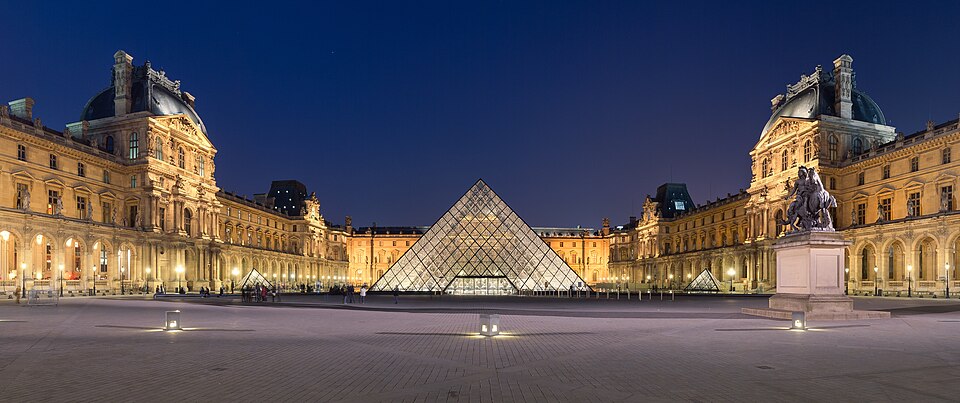The Louvre Museum: A Deep Dive
The Louvre Museum is arguably the most famous art museum in the world, a monumental landmark in Paris, France, and a treasure trove of human history and artistic achievement. Here’s a comprehensive overview, covering its history, collections, highlights, practical information, and more:
1. History – From Fortress to Museum
- Origins as a Fortress (12th Century): The Louvre began as a fortress built by King Philip II in 1190 to protect Paris. It was a defensive structure, not intended for art.
- Royal Residence (14th – 18th Centuries): Over the centuries, it evolved into a royal palace, expanded and renovated by successive monarchs. Kings like Charles V, Francis I, and Louis XIV all left their mark. Francis I was a major art collector and began assembling a royal collection.
- The French Revolution & Opening as a Museum (1793): During the French Revolution, the Louvre was nationalized and opened to the public as a museum on August 10, 1793. This was a radical act, making art accessible to everyone, not just the elite.
- Napoleonic Era (Early 19th Century): Napoleon Bonaparte significantly expanded the collection through conquests, renaming it the Musée Napoléon. Many artworks were looted from across Europe. After Napoleon’s defeat, many of these were returned.
- Continued Expansion & Modernization (19th – 21st Centuries): The museum continued to grow, with additions and renovations throughout the 19th and 20th centuries. The most iconic modern addition is I.M. Pei’s glass pyramid (completed in 1989), which serves as the main entrance.
2. The Collection – A Global Panorama
The Louvre’s collection is vast and diverse, spanning millennia and cultures. It’s divided into eight curatorial departments:
- Egyptian Antiquities: One of the most comprehensive collections outside of Egypt, featuring sarcophagi, sculptures, jewelry, and everyday objects.
- Near Eastern Antiquities: Art and artifacts from Mesopotamia, Persia, and the Levant, including the Code of Hammurabi.
- Greek, Etruscan, and Roman Antiquities: Sculptures, pottery, bronzes, and mosaics from ancient civilizations. The Venus de Milo is a highlight.
- Islamic Art: A relatively recent addition, showcasing a rich collection of art from the Islamic world.
- Sculptures: From ancient to modern, including masterpieces by Michelangelo and Canova.
- Decorative Arts: Furniture, ceramics, tapestries, and jewelry from the Middle Ages to the 19th century.
- Paintings: The most famous department, featuring works by European masters from the 13th to the 19th centuries.
- Prints and Drawings: A vast collection of works on paper, including sketches, engravings, and lithographs.
3. Iconic Highlights – Must-See Masterpieces
- Mona Lisa (Leonardo da Vinci): The most famous painting in the world, known for its enigmatic smile. Expect crowds!
- Venus de Milo: A celebrated ancient Greek sculpture of Aphrodite (Venus).
- Winged Victory of Samothrace: A dramatic Hellenistic sculpture depicting the goddess Nike (Victory).
- Liberty Leading the People (Eugène Delacroix): A powerful Romantic painting commemorating the July Revolution of 1830.
- The Wedding Feast at Cana (Paolo Veronese): A massive and vibrant Renaissance painting.
- Code of Hammurabi: An ancient Babylonian law code inscribed on a stone stele.
- Great Sphinx of Tanis: A monumental Egyptian sphinx.
- Psyche Revived by Cupid’s Kiss (Antonio Canova): A stunning Neoclassical sculpture.
4. Practical Information for Visitors
- Location: Paris, France (1st arrondissement). Address: Rue de Rivoli, 75001 Paris, France.
- Opening Hours: Generally 9:00 AM to 6:00 PM, closed on Tuesdays. Late night openings on Fridays until 9:45 PM. Always check the official website for current hours, as they can change.
- Tickets: Advance booking is highly recommended to avoid long queues. Tickets can be purchased online through the official Louvre website: https://www.louvre.fr/en
- Cost: Around €17 online, €15 at the museum (subject to change). Free admission for EU residents under 26, and on the first Friday evening of each month (except July and August).
- Getting There:
- Metro: Palais-Royal–Musée du Louvre (lines 1 & 7)
- Bus: Several bus lines stop near the Louvre.
- Vélib’: Paris’s bike-sharing system.
- Accessibility: The Louvre is accessible to visitors with disabilities. Wheelchairs are available.
- Food & Drink: There are several cafes and restaurants within the museum, as well as options nearby.
- Security: Expect airport-style security checks. Large bags may not be allowed.
- Website: https://www.louvre.fr/en
5. Tips for Visiting
- Plan Ahead: The Louvre is enormous. Decide what you want to see beforehand and map out a route.
- Download the Louvre App: Provides maps, information about artworks, and audio guides.
- Go Early or Late: Avoid the biggest crowds by visiting first thing in the morning or during late-night openings.
- Consider a Guided Tour: A tour can help you navigate the museum and learn more about the artworks.
- Wear Comfortable Shoes: You’ll be doing a lot of walking!
- Pace Yourself: Don’t try to see everything in one visit. Focus on a few key areas.
- Take Breaks: Rest your feet and recharge at one of the cafes.
- Be Aware of Pickpockets: Keep your belongings secure.
In conclusion, the Louvre Museum is more than just a museum; it’s a cultural icon, a historical landmark, and a testament to the power of human creativity. A visit to the Louvre is an unforgettable experience.
Do you have any specific questions about the Louvre that you’d like me to answer? For example, are you interested in:
- Specific artworks?
- The architecture of the museum?
- The history of the glass pyramid?
- Tips for visiting with children?
- Nearby attractions?
